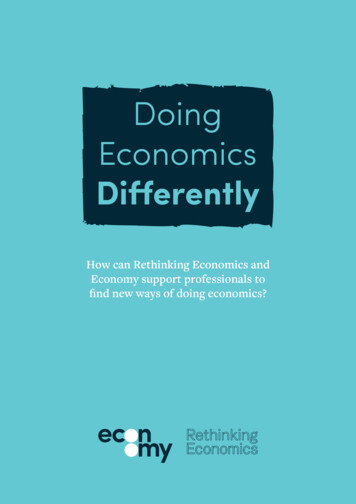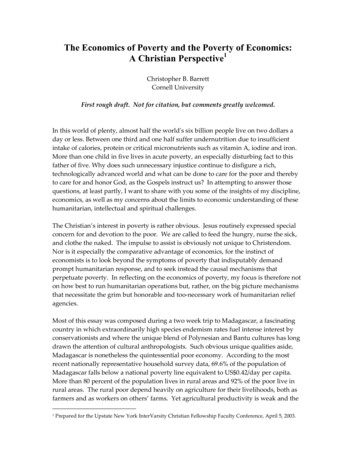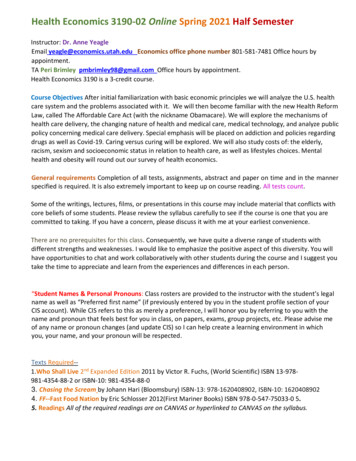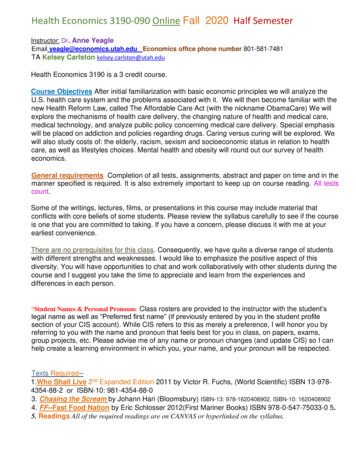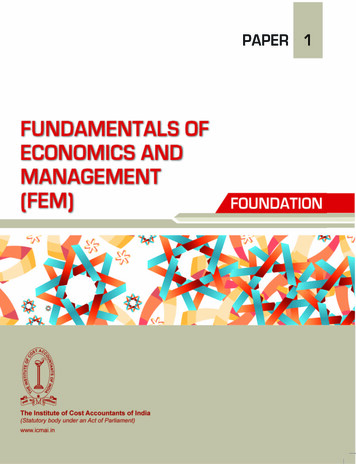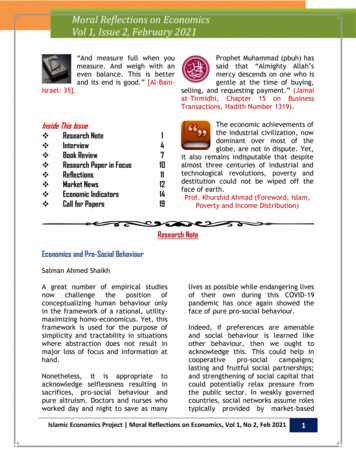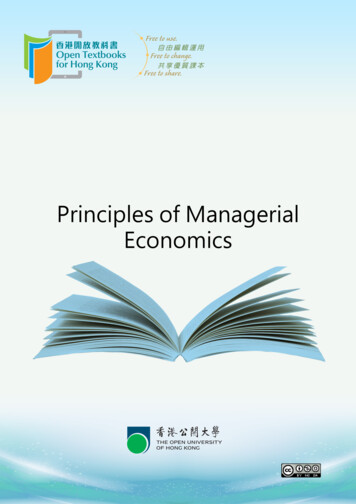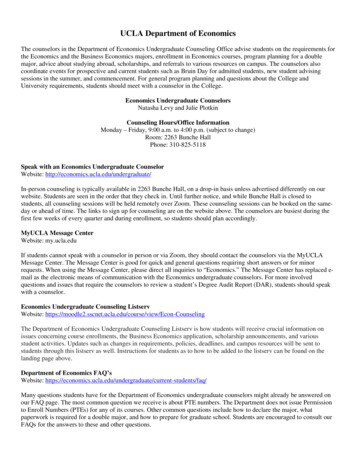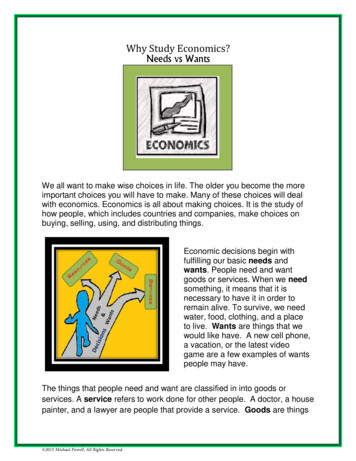
Transcription
—N.Gregory Mankiw, Professor of Economics, Harvard University, and author of Principles of EconomicsGoogle’s chief economist, Hal Varian, once wrote, “Youdon’t need a brand-new economics. You just need to seethe really cool stuff, the material they didn’t get towhen you studied economics.” The Cartoon Introductionto Economics is all about integrating the really coolstuff—such as auction theory, adverse selection, and thePrisoners’ Dilemma—into the funniest and mostdigestible overview of microeconomics you’ll ever read.“Hilarity and economics are not often found together, but this book has a lot of both.It also does a great job of explaining important economic concepts simply, accurately,and entertainingly—quite a feat.” —Eric Maskin, Nobel Laureate in Economics“Bauman and Klein present solid basic economics in a brilliant cartoon wrapper.Theauthors successfully shine a happy light on the dismal science.”—Hugo Sonnenschein, Distinguished Service Professor and President Emeritus, University of Chicago“This is a seriously funny book! Klein and Bauman offer an enlightening and entertaininglook at why our day-to-day choices matter and how they all combine.Students will findthis a great addition to their textbooks, and critics of the discipline will learn whateconomics is really about.” —Diane Coyle, author of The Soulful Science“Had Art Spiegelman and John Maynard Keynes collaborated on a comicbook on economics, they could only have dreamed of coming up withsomething this good.” —Jonathan A.Shayne, a.k.a.Merle Hazard,country singer and founder of Shayne & Co., LLCA freelance cartoonist, illustrator, and animator,Grady Klein is the creator of the Lost Colonyseries of graphic novels. 17.95BUSINESS / GRAPHIC NOVELSISBN: 978-0-8090-9481-35 1 7 9 5 Cover art and design by Grady KleinPhotograph of Grady Klein Anne Caswell KleinPhotograph of Yoram Bauman Andrea M.LeeHill and WangThecartoonintroduction toeconomicsvolume one: microeconomicsklein and baumanAn environmental economist at the University ofWashington (and a part-time teacher at Seattle’sLakeside High School), Yoram Bauman alsoperforms around the world as the world’s firstand only stand-up economist.The cartoon introduction to economicsvolume one: Microeconomics“Learning economics should be fun.Klein and Bauman make sure that it is.”A division of Farrar, Straus and Girouxwww.fsgbooks.com97 8080909 4 8 1 3www.cartooneconomics.comnovelgraphicsBy Grady Klein andYoram Bauman, Ph.D.hillandwangthe World’s first and only Stand-up Economist
contentsPART ONE:THE OPTIMIZINGINDIVIDuALPART TWO:STRATEGICINTERACTIONSPART Three:MARKETINTERACTIONSChapter 1Introduction, page 3Chapter 2Decision Trees, page 15Chapter 3Time, page 27Chapter 4Risk, page 39Chapter 5From One to Some, page 53Chapter 6Cake Cutting, page 67Chapter 7Pareto Efficiency, page 79Chapter 8Simultaneous-Move Games, page 89Chapter 9Auctions, page 103Chapter 10From Some to Many, page 117Chapter 11Supply and Demand, page 129Chapter 12Taxes, page 143Chapter 13Margins, page 155Chapter 14Elasticity, page 169Chapter 15The Big Picture, page 181Chapter 16Conclusion, page 193Glossarypage 205
chapter15The big pictureeconomists see the worlddifferently.There are powerfulmarket forcesall around us!where?apples 1.52
The economic worldview is strongly influenced by one simple idea:competitive markets are great!Lots ofbuyers .and lots ofsellers .all small relative tothe market as a whole!hooray!The benefits of competitive markets can be seen from the Coase theorem.if there’s nothingto stop people fromtrading .then nothing willstop people fromtrading!so buyers withhigh marginalbenefits .will trade withsellers with lowmarginal costs .and the result willbe Pareto efficient!182q
more formally, economists often respond to the big question by talking abouta result called the Invisible Hand Theorem.Under whatcircumstances doesindividual optimizationlead to outcomes thatare good for the groupas a whole?In a perfect world,competitive marketswill lead to a Paretoefficient outcome!of course, the world we live in is not perfect.but economists still think about competitive marketsthe same way that regular people think about puppies.It’s soadorable!But how do wetake care of it?here are a fewgood rules:Rule #1: Understand themarket’s limitationsRule #2: ProtectcompetitionRule #3: Give themarket secondchances183
Rule #1: understand the market’s limitations.heel!RuFf!RuFf!Just like you can have a Pareto efficient outcome where one kid gets all the cake .I don’thave any!Nyahnyah!Thhhppt!.you can have competitive markets that lead to outcomes thatare Pareto efficient but are not what most people would consider to be good.I’m starving!I’m stuffed!But here too economists see the world differently.184
when addressing inequality, economiststend to favor policies that minimizeintervention in well-functioningcompetitive markets .something tells meyou should be reallycareful about whereyou drop that.and maximizeindividual choice.instead of directly givingpoor people goods andservices we should justgive them money.That leaves as manychoices as possible upto each individual .And who’s betterat optimizing thanthe individual?giving starving people money instead of food may sound odd, but historyshows that many famines weren’t caused by lack of food but by lack of money.research by Amartya Sen, whowon the 1998 Nobel prize, showedthat some famine-stricken areasactually exported food.Lack of money isthe root of all evil.Congratulations,you win theNobel Prize!185
Rule #2: Protect competition.it’s dangerousout there!markets need referees .Okay, no colluding, noprice fixing, and nohitting below the belt!.because companies have an incentive to fix prices or form cartels orotherwise engage in anti-competitive behavior.psst .If we bothcharge highprices .then we’llboth makemore money!186we learned thaton page 102!
In the 19th century, cartels were known as trusts, which is why policiesto protect competition are called antitrust policies.I know it’s tempting tocollude, but if you do,I’m going to put youbehind bars!i object to thismerger!It’s not illegal tobe big and strong,but you better notabuse your marketpower.here at theantitrustdivision .we don’ttrust anybody.And in cases where competition is limited or impossible,governments can work to limit the extent of damage to consumers.No, you can’t charge 900 a month forelectricity!You’re aregulatedmonopoly!187
Rule #3: Give the market second chances.we are going tohave to do sometraining!looks likesomebody had amarket failure.Sometimes competitive markets create big messes, like pollution.-cough-cough-where’s theinvisible handwhen we need it?Economists think of pollution as an external cost,meaning a cost imposed on a third party.I’m delightedto sell you thisgasoline!I’m delightedto buy it fromyou!188-cough-cough-
These external costs are at the heart of the tragedy of the commons.optimizing behaviorby individuals .can produce anoutcome .-cough-cough--cough-cough-.that is bad foreveryone.-cough-cough-From the perspective of supply and demand, the problem is that external costscreate a gap between private marginal costs and social marginal costs.veinatoslcpgarmialveurcsoif i don’t have to bear thefull cost of my actions,of course i’m going topollute a lot!external cost ofpollutionrcuolcnagicstrteivamaprqWhen you look at the problem this way, it’s easy to see that the solution proposedby economists is to use market forces to correct market failure.The way toget people topollute less .is to makepollutingexpensive!Wow, now that’san idea worthy of aNobel prize!189
One way to make polluting expensive is to impose acarbon tax or other type of pollution tax.Anyone who wants tosell fossil fuels hasto pay a carbon tax!a properly designed pollution tax can close the gap betweenprivate marginal costs and social marginal costs.pervoslcnagiutcrvestolcarlminacuBy increasing privatemarginal costs .the pollution taxinternalizes theexternal costs!rgiaocaemstivaprqIt sounds like magic, but don’t forget what we learned about taxes:Market forces will pushsome if not all of the taxburden from sellersonto buyers .which means we’llall have to payhigher prices forthings like gasoline!just a half atank, please.190we can getclean air .but we can’tget a freelunch!
an alternative to a pollution tax isa system that involves a cap.we’re going toissue permits for alimited amount ofpollution .and you can’tpollute withouta permit!.and trade.Companies canbuy or sellthis givespermits.them maximumflexibility.so they canmake Paretoimprovements bytrading!cap-and-trade sounds very different from a Pollution tax,but in fact they’re practically identical.they both work bymaking pollutionexpensive!Neither one ismagic, but both ofthem do come with aspecial bonus .191
the special bonus ofpollution taxes isthat they generaterevenue .Cap-and-trade canalso generaterevenue .if you use anauction tosell the permits!.and we can use this revenue tolower existing taxes.Lower taxes onworking!Lower taxes onsaving!Why tax goodswhen we cantax bads?Lower taxes oninvesting!The way economists see the world,taxes and pollution are two unfortunate realitiesthat go great together!in this case, twowrongs reallydo make a right!192isn’t the worldheavenly?
—N.Gregory Mankiw, Professor of Economics, Harvard University, and author of Principles of EconomicsGoogle’s chief economist, Hal Varian, once wrote, “Youdon’t need a brand-new economics. You just need to seethe really cool stuff, the material they didn’t get towhen you studied economics.” The Cartoon Introductionto Economics is all about integrating the really coolstuff—such as auction theory, adverse selection, and thePrisoners’ Dilemma—into the funniest and mostdigestible overview of microeconomics you’ll ever read.“Hilarity and economics are not often found together, but this book has a lot of both.It also does a great job of explaining important economic concepts simply, accurately,and entertainingly—quite a feat.” —Eric Maskin, Nobel Laureate in Economics“Bauman and Klein present solid basic economics in a brilliant cartoon wrapper.Theauthors successfully shine a happy light on the dismal science.”—Hugo Sonnenschein, Distinguished Service Professor and President Emeritus, University of Chicago“This is a seriously funny book! Klein and Bauman offer an enlightening and entertaininglook at why our day-to-day choices matter and how they all combine.Students will findthis a great addition to their textbooks, and critics of the discipline will learn whateconomics is really about.” —Diane Coyle, author of The Soulful Science“Had Art Spiegelman and John Maynard Keynes collaborated on a comicbook on economics, they could only have dreamed of coming up withsomething this good.” —Jonathan A.Shayne, a.k.a.Merle Hazard,country singer and founder of Shayne & Co., LLCA freelance cartoonist, illustrator, and animator,Grady Klein is the creator of the Lost Colonyseries of graphic novels. 17.95BUSINESS / GRAPHIC NOVELSISBN: 978-0-8090-9481-35 1 7 9 5 Cover art and design by Grady KleinPhotograph of Grady Klein Anne Caswell KleinPhotograph of Yoram Bauman Andrea M.LeeHill and WangThecartoonintroduction toeconomicsvolume one: microeconomicsklein and baumanAn environmental economist at the University ofWashington (and a part-time teacher at Seattle’sLakeside High School), Yoram Bauman alsoperforms around the world as the world’s firstand only stand-up economist.The cartoon introduction to economicsvolume one: Microeconomics“Learning economics should be fun.Klein and Bauman make sure that it is.”A division of Farrar, Straus and Girouxwww.fsgbooks.com97 8080909 4 8 1 3www.cartooneconomics.comnovelgraphicsBy Grady Klein andYoram Bauman, Ph.D.hillandwangthe World’s first and only Stand-up Economist
An environmental economist at the University of Washington (and a part-time teacher at Seattle’s Lakeside High School), Yoram Bauman also performs around the world as the world’s first and only stand-up economist. A freelance cartoonist, illustrator, and animator, Grady Klein is the cr


